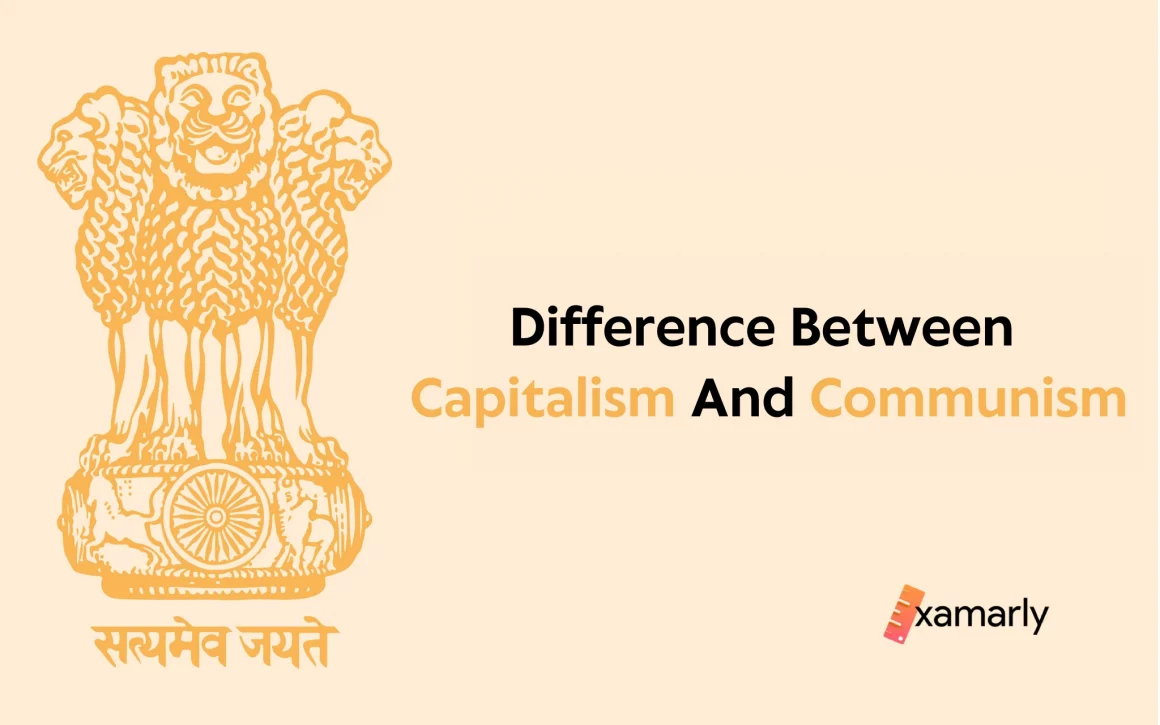Are you intrigued by the fundamental difference between capitalism and communism? These two economic and political systems have been the centre of heated debate and discussions for centuries, and it’s no surprise why.
On one hand, we have capitalism – an economic system where private individuals and businesses own the means of production and operate for profit. On the other hand, there’s communism – an economic system where the means of production are owned and controlled by the community as a whole.
While these systems may have some similarities, there are also crucial distinctions between them. In this blog post, we’ll dive deep into the distinctions between communism and capitalism, examining their economic systems, political structures, and the impact they have on society.
We’ll also take a closer look at the pros and cons of each system and how they’ve been implemented in various countries throughout history. So, buckle up, and let’s start exploring the ideologies.
- What Is Capitalism?
- What Are The Significant Aspects Of Capitalism?
- What Is The Origin Of The Term Capitalism?
- What Is Capitalist Economy?
- Role Of Government In Capitalist Economy
- Examples Of Capitalism
- What Is Communism?
- What Are The Significant Aspects Of Communism?
- What Is The Origin Of The Term Communism?
- What Is Communist Economy?
- Role Of Government In Communist Economy
- Examples Of Communism
- Capitalism Vs Communism – Key Contrasts
- Closing Thoughts
- Frequently Asked Questions
- What is capitalism?
- What is communism?
- What are the dissimilarities between capitalism and communism?
- What are the advantages of capitalism?
- What are the disadvantages of capitalism?
- What are the advantages of communism?
- What are the disadvantages of communism?
- Can capitalism and communism coexist?
- Is capitalism better than communism?
What Is Capitalism?
Capitalism is an economic system in which private individuals and businesses own and control the means of production, and operate for profit. The goal of capitalism is to create wealth and improve living standards through economic growth.
In a capitalist system, the government’s role is typically limited to protecting property rights and enforcing contracts, and prices are determined by supply and demand in the market. This means that businesses are free to produce and sell goods and services as they see fit, and consumers are free to buy them. Capitalism is based on the idea that individuals acting in their self-interest will ultimately benefit the entire society.
What Are The Significant Aspects Of Capitalism?
- Private property ownership, where individuals and companies own and control resources such as factories, machines, and equipment.
- Freedom of enterprise, where individuals and businesses have the right to make their own economic decisions without government interference.
- Profit motive, where the drive to earn profits is a key motivator in capitalist economies.
- Market-determined prices, where the prices of goods and services are determined by the forces of supply and demand without government intervention.
- Consumer sovereignty, where consumers have the power to influence production levels and the types of goods and services offered through their purchasing decisions.
- Free trade, where low barriers to international trade are promoted in capitalist economies.
- Limited government intervention in the economy, where the government plays a minimal role in the daily operations of businesses.
- Flexibility in labour markets, where there is flexibility in hiring and firing of the workforce.
- Freedom of ownership, where individuals have the right to accumulate and use the property as they see fit.
What Is The Origin Of The Term Capitalism?
The term “capitalism” is derived from the Latin word “capitalis,” which means “of the head” or “chief.” It was first used by the French economist and political theorist Charles Dupin in 1844 to describe the economic system in which private individuals or businesses own and operate the means of production and distribution of goods and services. The term was later popularized by Karl Marx and Friedrich Engels in their critique of the capitalist system in their 1867 book, “Capital: Critique of Political Economy.”
The origins of capitalism as an economic system can be traced back to the 16th century, and modern capitalist theory is typically linked to the 18th-century work, “An Inquiry into the Nature and Causes of the Wealth of Nations,” written by Scottish political economist Adam Smith.
What Is Capitalist Economy?
A capitalist economy is an economic system in which private individuals and businesses own the means of production and distribution of goods and services. The goal of a capitalist economy is to create wealth through the efficient use of resources and the creation of goods and services that are in high demand. Prices are determined by supply and demand, and profits serve as an incentive for businesses to produce and innovate.
The government generally plays a limited role in a capitalist economy, allowing market forces to dictate the economy’s direction. However, the level of government intervention varies, and there are different types of capitalism.
Role Of Government In Capitalist Economy
In a capitalist economy, the role of government is generally limited. The government’s main function is to create and maintain the conditions that allow for a free market economy to function. This includes:
- Protecting property rights: The government is responsible for protecting the rights of individuals and businesses to own and control the property. This includes enforcing contracts and resolving disputes.
- Providing public goods and services: The government provides certain goods and services that the market cannot provide efficiently, such as national defence, infrastructure, and education.
- Regulating economic activity: The government regulates certain aspects of economic activity to ensure that the market functions efficiently and fairly. This includes enforcing antitrust laws to prevent monopolies and regulating the banking and securities industries to protect consumers.
- Providing a safety net: The government provides a safety net for those who are unable to participate in the market, such as the elderly, disabled, and unemployed.
- Taxation: The government raises revenue through taxation, which is used to fund government programs and services.
In capitalist economies, the government generally does not own or control the means of production. The economy is driven by private enterprise and competition, with individuals and businesses making decisions based on their self-interest.
Examples Of Capitalism
There are several examples of capitalist economies in the world, including:
- The United States: The U.S. has a mixed economy that is primarily capitalist, with private individuals and businesses owning the means of production and distribution of goods and services.
- The United Kingdom: The UK has a capitalist economy with a strong tradition of private enterprise and a relatively small public sector.
- Japan: Japan’s economy is capitalist, with a high level of government intervention in certain industries, such as transportation and utilities.
- Canada: Canada has a capitalist economy with a high degree of government involvement in certain sectors, such as healthcare and education.
- Australia: Australia has a capitalist economy with a strong tradition of private enterprise and a relatively small public sector.
- Singapore: Singapore is known for its capitalist economy with strong government intervention, it is considered a model of state capitalism.
These are just a few examples, many other countries have capitalist economies with different variations and levels of government intervention.
What Is Communism?
Communism is a political and economic ideology that seeks to establish a classless, stateless society in which the means of production are collectively owned and controlled. The ultimate goal of communism is to achieve a stateless, classless society in which there is no exploitation of one person by another. It is based on the principles of common ownership, equality, and the absence of social classes.
The theory of communism is primarily associated with Karl Marx and Friedrich Engels, who outlined the principles of communism in the Communist Manifesto (1848). The most well-known example of a communist government was the Soviet Union, which existed from 1922 to 1991.
What Are The Significant Aspects Of Communism?
Some key features of communism include:
- Collective ownership: The means of production, such as factories and land, are owned and controlled by the community as a whole, rather than by individuals or private companies.
- No social classes: In a communist society, there are no distinctions between rich and poor, and everyone has access to the same resources and opportunities.
- Economic equality: In a communist society, wealth and resources are distributed according to the principle of “from each according to his ability, to each according to his need.”
- Abolition of private property: In a communist society, private property is abolished and replaced with collective ownership.
- Centralized decision-making: Decisions about the economy and other aspects of society are made by a central authority, rather than by individuals or groups of individuals.
- No market economy: In a communist society, there is no market economy, and goods and services are distributed according to a plan developed by the central authority.
- State control: The state controls the economy and society, and it is the main driving force behind the implementation of the communist ideology.
It’s worth mentioning that in practice, most of the countries that have been called communist have not fully implemented these features and have deviated in many ways from the ideal communist society as described by Karl Marx and Friedrich Engels.
What Is The Origin Of The Term Communism?
The origin of communism can be traced back to the ideas of Karl Marx and Friedrich Engels, who developed the theory of communism in the mid-19th century. Marx and Engels were critical of the capitalist system, which they saw as exploitative and unjust. They believed that the working class, or the “proletariat,” was being exploited by the capitalist class or the “bourgeoisie,” and that this exploitation would eventually lead to a revolution.
In 1848, Marx and Engels published the Communist Manifesto, which outlined their ideas on communism and called for the overthrow of the capitalist system. In it, they argued that the history of society is the history of class struggle and that the ultimate goal of this struggle is the establishment of a classless, stateless society in which the means of production are collectively owned and controlled.
Marx and Engels’ ideas on communism were heavily influenced by the Industrial Revolution, which was taking place in Europe at the time. They saw the rise of industrial capitalism as a major source of exploitation and inequality and believed that a communist revolution was necessary to bring about a more just and equal society.
What Is Communist Economy?
A communist economy is an economic system in which the means of production are collectively owned and controlled by the state or the community as a whole. The goal of a communist economy is to achieve a classless, stateless society in which there is no exploitation of one person by another and everyone has access to the same necessities.
In a communist economy, the government makes all economic decisions and there is no private property ownership. This eliminates the capitalist class and the exploitation of the working class that occurs in capitalist economies.
The economy is centrally planned by the government, which sets production quotas and makes decisions about the allocation of resources. This is intended to ensure that everyone has access to the same necessities and to eliminate the economic inequality that exists in capitalist societies.
In a communist economy, money is abolished, and resources are distributed according to need rather than being bought and sold. This eliminates the need for a market economy and the role of money.
Communist economies also aim to eliminate unemployment by providing jobs for all citizens. This can be done by having the government provide jobs or by having state-run industries.
Role Of Government In Communist Economy
In a communist economy, the role of government is centralized and dominant. The government owns and controls the means of production and makes all economic decisions. The government’s main functions include:
- Planning and directing the economy: The government sets production quotas and makes decisions about the allocation of resources to achieve the goals of the economy, such as full employment and a fair distribution of wealth.
- Owning and managing the means of production: The government owns and controls the land, factories, and other means of production. This eliminates the capitalist class and the exploitation of the working class that occurs in capitalist economies.
- Providing public goods and services: The government provides certain goods and services that the market cannot provide efficiently, such as national defence, infrastructure, and education.
- Regulating prices and wages: The government regulates prices and wages to ensure that they are fair and that everyone has access to the same necessities.
- Providing a safety net: The government provides a safety net for those who are unable to participate in the market, such as the elderly, disabled, and unemployed.
- Abolishing money: The government eliminates money as we know it, and resources are distributed according to need rather than being bought and sold.
- Eliminating unemployment: The government guarantees jobs for all citizens.
It’s important to note that the role of government in communist economies can vary greatly depending on the country and the specific policies in place. Some governments may have a more active role in the economy than others, and the implementation of these ideas in practice has varied greatly in different communist countries and not all of the principles of communism were fully implemented in any of the countries.
Examples Of Communism
Examples of countries that have implemented communism as a political and economic system include:
- Soviet Union: The Soviet Union, which existed from 1922 to 1991, was the first country to officially adopt communism as a political and economic system. The Soviet Union was a one-party state controlled by the Communist Party of the Soviet Union, and the economy was centrally planned. The Soviet Union’s economy was characterized by a lack of efficiency, shortages of goods and services, and a lack of incentives for individuals to work hard and innovate.
- China: China adopted communism after the Chinese Revolution in 1949. Like the Soviet Union, China was a one-party state controlled by the Communist Party of China, and the economy was centrally planned. China’s economy has undergone significant changes in recent years, moving away from a planned economy to a more market-oriented one.
- Vietnam: Vietnam adopted communism after the Vietnam War in 1975. Vietnam was a one-party state controlled by the Communist Party of Vietnam, and the economy was centrally planned. However, in recent years Vietnam has adopted a more market-oriented approach to its economy.
- Cuba: Cuba adopted communism after the Cuban Revolution in 1959. Cuba was a one-party state controlled by the Communist Party of Cuba, and the economy was centrally planned. The Cuban economy has been characterized by a lack of economic efficiency, shortages of goods and services, and a lack of incentives for individuals to work hard and innovate.
- Laos: Laos adopted communism after the Laotian Revolution in 1975. Laos was a one-party state controlled by the Lao People’s Revolutionary Party, and the economy was centrally planned.
Capitalism Vs Communism – Key Contrasts
| Feature | Capitalist Economy | Communist Economy |
|---|---|---|
| Ownership of the means of production | Private | Collective (by the state or community) |
| Private property | Allowed | Abolished |
| Role of government in the economy | Limited | Centralized |
| Allocation of resources | Market-based | Centrally-planned |
| Economic incentives | Profit-driven | Based on need |
| Distribution of wealth | Unequal | Equal |
| Market economy | Present | Absent |
| Competition | Encouraged | Limited or absent |
| Employment | Market-driven | Guaranteed |
It’s important to note that the table is a general representation of the differences between the two systems and in practice, the implementation of these features has varied greatly in different countries and the real-world economy is a mixture of different models.
Closing Thoughts
In conclusion, capitalism and communism are two different economic and political systems with distinct characteristics. Capitalism is a system in which the means of production are privately owned and controlled, and the market dictates the allocation of resources. The government’s role is limited to protecting property rights and providing public goods and services.
On the other hand, communism is an economic and political system in which the means of production are collectively owned and controlled by the state or community, and the government makes all economic decisions. The ultimate goal of communism is to achieve a classless, stateless society in which there is no exploitation of one person by another. Both systems have their advantages and disadvantages and the implementation of these systems in practice has varied greatly in different countries.
Explore Our Latest Posts
States and Union Territories Of India
Difference Between Socialism And Communism
Difference Between Capitalism And Socialism
Frequently Asked Questions
What is capitalism?
Capitalism is an economic and political system in which the means of production are privately owned and controlled, and the market dictates the allocation of resources. The government’s role is limited to protecting property rights and providing public goods and services.
What is communism?
Communism is an economic and political system in which the means of production are collectively owned and controlled by the state or community, and the government makes all economic decisions. The ultimate goal of communism is to achieve a classless, stateless society in which there is no exploitation of one person by another.
What are the dissimilarities between capitalism and communism?
The main differences between capitalism and communism are the ownership of the means of production, the role of government in the economy, and the allocation of resources. In capitalism, the means of production are privately owned and the market dictates the allocation of resources, while in communism, the means of production are collectively owned and the government makes all economic decisions.
What are the advantages of capitalism?
Some of the advantages of capitalism include economic growth, efficient allocation of resources, and individual freedom and initiative.
What are the disadvantages of capitalism?
Some of the disadvantages of capitalism include income inequality, lack of access to necessities for some individuals, and potential for monopolies.
What are the advantages of communism?
Some of the advantages of communism include equal distribution of wealth, guaranteed employment and access to necessities for all, and the absence of social classes.
What are the disadvantages of communism?
Some of the disadvantages of communism include a lack of economic efficiency, shortages of goods and services, a lack of incentives for individuals to work hard and innovate, and a lack of individual freedoms.
Can capitalism and communism coexist?
In theory, capitalism and communism can coexist, but in practice, it is rare as the two systems have different fundamental principles and are often in conflict.
Is capitalism better than communism?
This is a subjective question and opinions on the answer vary widely. Some argue that capitalism is better because it leads to economic growth and individual freedom and initiative, while others argue that communism is better because it leads to equal distribution of wealth and access to necessities for all.






